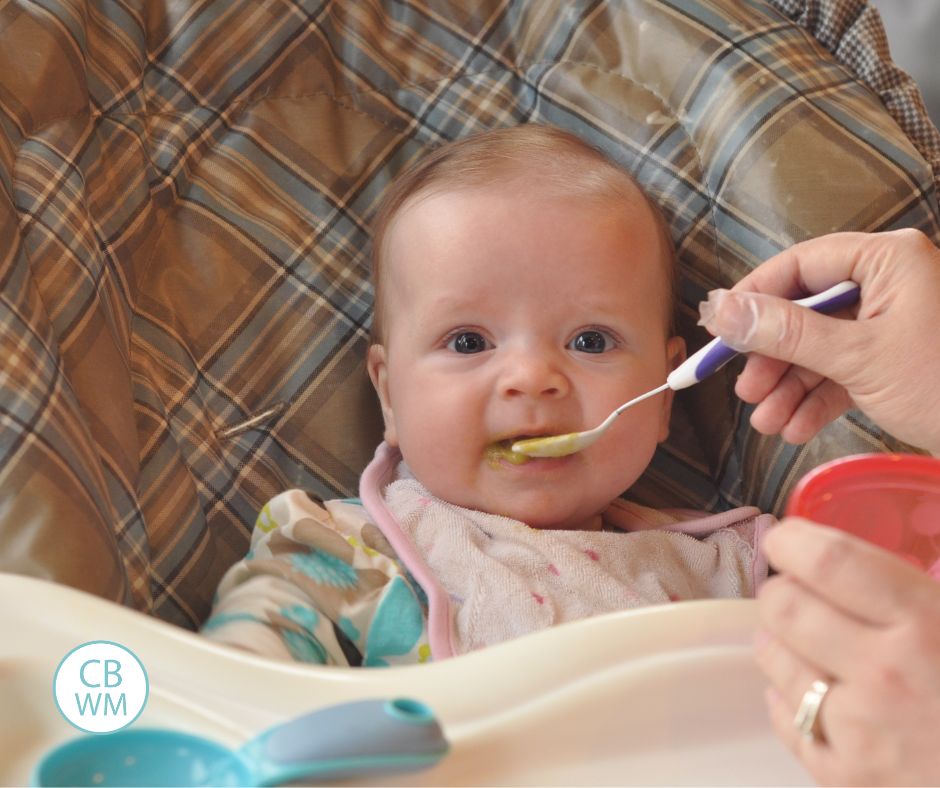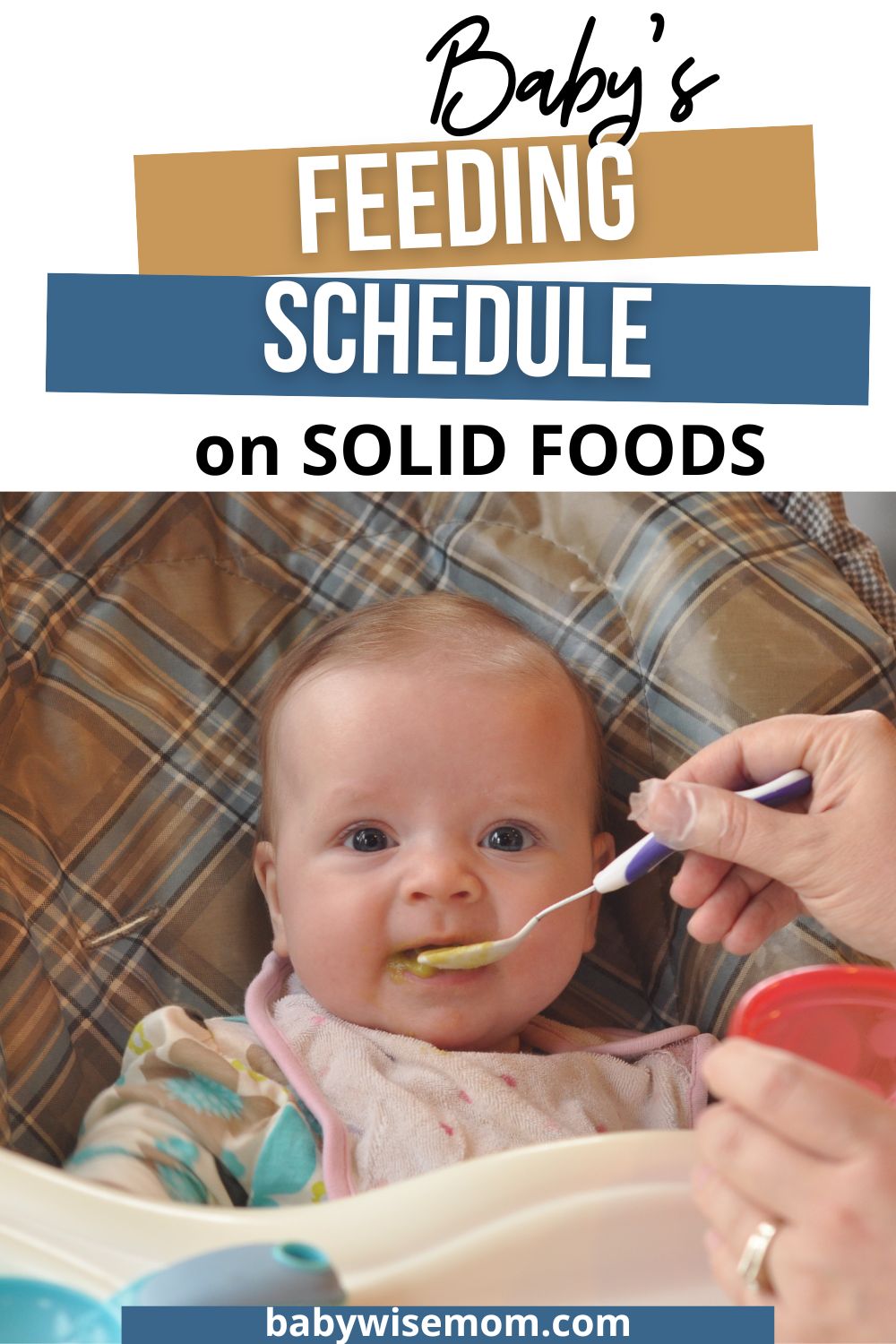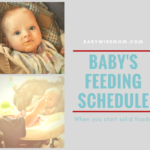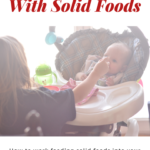When it is time to start solid foods, the daily schedule may shift some, but your pattern of eat/wake/sleep should stay the same. This post outlines when and where solid foods should fall in your baby’s daily schedule.

One of my favorite stages with babies is introducing solid foods to them. Even when you introduce a food they love, their reaction to the first bite is often worthy of an America’s Funniest Home Videos entry. The nose gets scrunched up, the eyes may shut, and a shiver runs through the body. You can rarely tell if your child will love a food or not from the first bite.
While starting solids is entertaining, it can also be confusing. When you are going through giggles, you may also wonder when your baby should be eating those solid foods. Right with the liquid feeding? Should it be spaced out? What is the right call? I have the answers for you. And the answer will probably surprise you.
Don’t make the mistake of feeding baby too often.
Post Contents
- Baby Feeding Schedule with Solid Foods
- What If Baby is Not Hungry For Solid Foods
- Baby-Led Weaning Solids Schedule
- Starting Solid Foods FAQs
- What Are Signs My Baby is Ready for Solid Foods?
- What Foods Should I Feed My Baby?
- How Much Solid Food Does Baby Need?
- Will My Baby Need Water?
- Conclusion
- Related Posts
Baby Feeding Schedule with Solid Foods
I often get questions that go something like this,
“Hello! My six month old hasn’t been sleeping well since we started solids. Can you see something wrong in our schedule?
7 AM Nurse
9 AM Solids
9:30 AM Nap
11 AM Nurse
1 PM Solids
1:30 PM Nap
4 PM Nurse
6 PM Solids
7 PM Bedtime”
I immediately know what the problem is when I see that schedule.
Do you see it?
The baby, who has been breastfeeding or bottlefeeding every 3-4 hours before starting solids, is suddenly being fed every two hours instead of every 3-4 hours.
A six month old does not need to eat more often than a six week old.
From the time you brought your baby home from the hospital, you worked on establishing a 2.5-3 hour routine, which meant your baby ate every 2.5-3 hours. As young as five weeks old, some babies can go 2.5-3.5 hours. By four months, many babies are on a four-hour feeding schedule.
Then we introduce solids and feed them every two hours.
Sure, there were times your baby ate every two hours, especially during growth spurts, but that was never what you were aiming for. If your baby tried to consistently eat every two hours, you would have scoured the book, this blog, and/or fellow Babywise mom brains for help on getting that feeding interval longer.
>>>Read: Why an Eat/Wake/Sleep Cycle Works to Get Baby Sleeping
When your baby starts solids, stick with the 3-4 hour feeding interval in your routine.
You have thus far avoided creating a “snacker” and want to continue with that now. Stick with eat/wake/sleep. When your baby wakes from a nap, start with your liquid feeding. Then move on to solids. Feed as much solid food as your baby will take–do not force more and do not limit it (unless you have been instructed otherwise by your baby’s pediatrician).
Once your baby is done eating the solids, have playtime. Finish up with a nap. Once baby wakes up from that nap, start the cycle again.
Feeding solids is not as confusing to work into your daily routine as it might seem at first. When you started a schedule with your baby in the beginning, you were starting as you mean to go on. Go on as you intended when you started. Feed the entire meal, milk and solids, at once. Feed every 3-4 hours. Land at 3 solid feedings a day. Do those things and you will be on the right course!
Using the above schedule as a guide, a feeding schedule with solid foods should look like this:
7 AM Nurse then solids
9:30 AM Nap
11 AM Nurse then solids
1:30 PM Nap
4 PM Nurse then solids*
7 PM Nurse then Bedtime
*The third solid feeding often falls at an awkward time of your day. You can do that final solid feeding at that 3 feed of the day or with the fourth feed of the day
Feed your baby solids three times per day. Do at least four liquid feedings each day.
That will mean that if you are on a four hour schedule with no dreamfeed, so you are at four feedings a day, your baby will not eat solids at every single meal. Pick three. The three you pick really don’t matter in general; it just matters that you pick the best three feedings for you and your baby.
You might pick your first meal of the day so that it is like “breakfast.” You might skip that first one because you have so much milk and your baby isn’t hungry enough to add solids.
Feeding solids adds a fair amount of time to your feeding time, so you might base when you feed solids based on what your daily routine looks like. If you have a 3 PM feeding and need to pick other children up from school at 3:30, for example, you might not want to do solids at 3 PM. I have had solid meals at different feedings among my four children. I always did what made the most sense with each child.
>>>Read: Baby Feeding Times for Solid Foods
What If Baby is Not Hungry For Solid Foods
If your baby is really not hungry at all for any solids, you can feed half of the liquid feeding, do solids, and then feed the other half of the liquid feeding. If you are breastfeeding, you feed one side, solids, second side (or do half time if you do single-side feedings). If you are bottle feeding with either breast milk or formula, do half of the bottle, solids, then second half of the bottle.
BUT remember that solid foods are just supplemental for a baby initially. It is okay for solid foods to be gradually added to your baby’s diet. You do not need full nutrition from solids as soon as you start feeding solids.
You want to get to three solid feedings per day at some point, but you don’t start there. Start with one. Give it some time (at least a few days, but maybe even as long as a couple of weeks) before adding a second. Give it some more time, then add your third.
Baby-Led Weaning Solids Schedule
Not everyone feeds purees. Many people love the idea of baby-led weaning and wonder if the solid food feeding schedule is different if you are doing baby-led weaning.
Keep the same pattern of eat/wake/sleep. A big difference with baby-led weaning and purees is that the parent has more control over the length of time the baby takes to eat when feeding purees. With that in mind, it is probably best to do the full liquid feeding and then follow up with the solid foods. Then you will have more patience for baby to take the time she needs to eat her food.
>>>Read: Tips to Be Successful With Baby-Led Weaning
Starting Solid Foods FAQs
Here are some common questions parents have when starting feeding solid foods.
What Are Signs My Baby is Ready for Solid Foods?
If you ask friends and family when your baby can start solid foods, you will probably get a variety of answers. The reason for this is that the American Academy of Pediatrics has had many different recommendations over the years on the exact age baby should be.
Here are current recommendations from the AAP:
- The baby can hold their own head up. The baby needs good head control.
- The baby is interested and will open their mouths when food comes their way.
- The tongue thrust reflex is gone. Your baby can swallow food.
- The baby has doubled their birth weight and weighs at least 13 pounds.
- The baby is at least four months of age, although the AAP recommends sticking to only breastmilk until 6 months old.
>>>Read: How To Introduce Solid Foods to Your Baby
What Foods Should I Feed My Baby?
There are a lot of options for what you can start feeding your baby when you first start solid foods. You want to start with single-ingredient foods. This enables you to watch for any reactions and allergies. Good first foods include:
- Baby cereals
- Banana
- Avocado
- Peas
- Sweet Potato
- Squash
- Carrots
- Green Beans
- Zucchini
- Prunes
- Peaches
- Pears
- Fruits
- Vegetables
As your baby becomes more familiar with the above foods, you want to also work to include the following:
- Yogurt
- Cottage Cheese
- Other dairy
- Broccoli
- Grapes
- Crackers
- Chicken and other meats
- Fish
- Eggs
- Table foods the family is eating
Before introducing any food with peanuts in it, it is wise to talk to your baby’s doctor.
Also, take note that severe eczema can be a sign of a food allergy, so if your baby has eczema, it can be wise to be more cautious with introducing foods with eggs and peanut products.
How Much Solid Food Does Baby Need?
Food amounts will really vary greatly from baby to baby. Some eat more than others. Go off or your baby’s hunger cues and fullness cues and respect those. Start with just a small amount of solid food. 1 Tablespoon of a vegetable at a meal might be all your baby needs. With my babies, I started with:
Breakfast: Solid foods were cereal and fruit. I did 1 tablespoon of each thing and added to it if they wanted more.
Lunch: One green veggie and one fruit. Again, 1 tablespoon of each food.
Dinner: One yellow veggie and one fruit. Again, 1 tablespoon of each food.
When I first introduced solid foods, I just did solids at one meal a day. Several days later, I did two meals a day. Several days later, I did three meals a day.
Read much more about our experiences in Common Questions When Starting Purees with Baby
Will My Baby Need Water?
Babies should be fine with their breast milk or formula, however you can offer some water if you like. Do not do more than one cup (8 ounces) of water a day and offer it in a sippy cup.
Conclusion
As you start solid foods, keep your solid feeding at the same time as your liquid feeding so that you still keep your 3-4 hour feeding schedule. This will avoid new sleep issues from starting.
Related Posts
- How To Make Sure You Are “Feeding the Rainbow”
- Baby Meal Planner {Free Printable}
- Parents Remember: Eating Solids is a New Skill
- Tips for Introducing Solids to Your Baby “Randomly”
- Feeding Solids on a Babywise Schedule
- Baby’s First 8 Weeks of Solid Foods

This post first appeared on this blog in June of 2017


